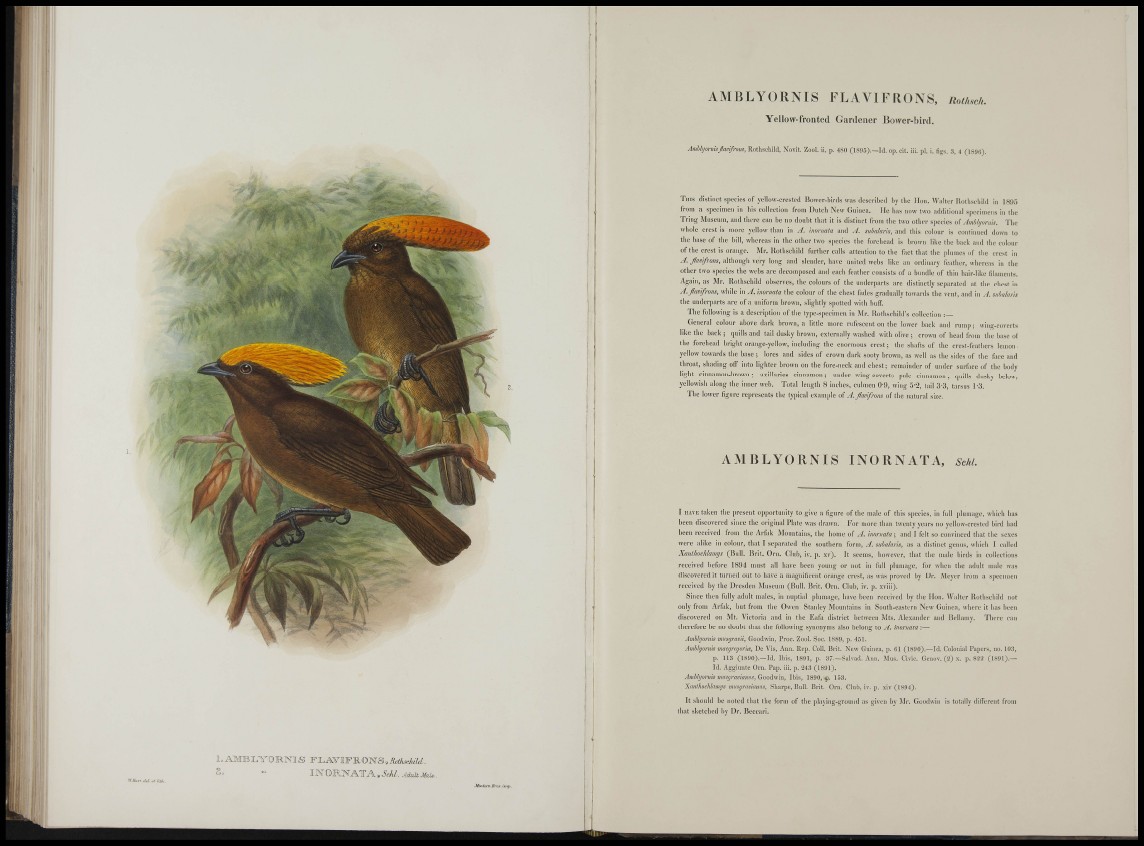
! l ' I
H'J/OTV Ud rf /M .
RdhscJuld.
Sehl. Adult Male..
.Mitx (em. brcs. in\p.
A M B L Y O R N I S F L A V I F R O N S , r i o i k s c i t .
Y e l l o w - f r o n t e d G a r d e n e r B o v ^ e r - b i r d .
Amlll/ornisJavi/roHS, Rothschild, Novit. Zool. ii. p. 480 (1895).—Id. op. cit. Hi. pi. i. figs, 3, 4 (1890).
THIS distinct species of yellow-crested Bower-birds w;is described by the Hon. Walter Rothschild in 18A5
f r om a specimen in his collection from Dutch New Gninea. He has now two iidditioiial speciraeti.s in the
T r i n g Mnseum, and there can be no doubt that it is distinct from the two otber species ui Ambhjnnds. The
whole crest is moi-e yellow tban in A. inormta and A. subnlaris, and this colour is contirnied down to
t h e base of the bill, wlicreas in the other two species tlie forcbead is brown lilie the back and the colour
of the crest is orai;ge. Mr. llotbscbild further calls altention to the fact that tbe plumes of the crest in
A. flamfrons, altliougb very long and slender, have united webs like an ordinary feather, whereas In the
othe r two species the webs are decomposed and each feather consists of a bundle of thin hair-like fdanients.
Again, as Mr. Rothschild observes, tbe colours of tbe uiulerparts are distinctly separated at the chest in
A. flamfrons, while in A. inornata the colour of the chest fades gradually towards the vent, and in A. siihidnns
the underparts are of a uniform brown, slightly spotted with iinif.
T h e following is a description of tbe type-siiecimen in Mr . Rothschild's collection
General colour above dark brown, a little more rufescent on tbe lower back and rump; wing-coverts
hke the back ; quills and tail dusky brown, e.xternally washed with olive ; crown of bead from tbe base of
t h e forehead bright orange-yellow, including the enormous crest; the shafts of the crest-feathers lemon
yellow towards the base ; lores and sides of crown dark sooty brown, as well as the sides of the face and
t h r o a t , shading off into lighter brown on the fore-neck and chest; remainder of under surface of tbe body
light cinnamon-brown ; axillaries ciniuirnon; under wing-coverts j)ale cinnamon; i|uills dusky below,
yellowish along the imier web. Total length 8 inches, cidmen O'O, wing 3-2, tail 3-3, tarsus 1-3.
T h e lower figure re|)resents the typical e-famjile o( A.flmifmns of the luitural size.
A M B L Y O R N I S I N O R N A T A , Schi.
I HAVE taken the present o))|iortuuity to give a figure of the male of this species, in full jilumage, which has
been discovered since the original Plate was drawn. For more than twenty years no yellow-crested bird had
been received from the Arfak Mountains, the home of A. hwrnata and I felt so convinced that tbe sexes
were alike in colour, that I separated the southern form, A. sukilaris, as a distinct genus, which I called
Xanthochlamijs (Bull. Brit. Orn. Club, iv. p. xv). It seems, however, that the male birds in collections
received before 1894 must all have been young or not in full plumage, for ivhen the adult male was
discovered it turned out to have a magnificent orange crest, as was proved by Dr. Meyer from a specimen
received by the Dresden Museum (Bull. Brit. Orn. CInb, iv. p. xviii).
Since then fully adult males, in nu])tiid plumage, have been received by the Hon. Walter Rothschild not
only from Arfak, but from the Owen Stanley Mountains in South-eastern New Guinea, where it has been
discovered on Mt. Victoria and in the Eafa district between Mts. Ale.xander and Bellamy. There can
t h e r e f o r e be no doubt that the following synonyms also belong to A. inornata :—
Amhlyornk musgrav'd, Goodwin, Proc. Zool. Soc. 1889, p. 451.
Amhhjornis macgrcgory, De Vis, Ann. Rep. Coll. Brit. New Guinea, p. G1 (1890) .—Id. Colonial Papers, no. 103,
p. 113 (ISilO).—Id. Ibis, 1891, p. 37.—Salvad. Ann. Mus. Civic. Genov. (2) x. p. 822 (1891).—
Id. Aggiunte Orn. Pap. iii. p. 243 (1891).
Amihjornis mtisgravimms, Goodwin, Ibis, 1890, 153.
Xanihochlamys nmsgravimnis, Sliarpe, Bull. Brit. Orn. Club, iv. p. xiv (1894).
I t should be noted that the form of the plajing-ground as given by Mr. Goodwin is totally difrerent from
that sketched by Dr. Beccari.